Tiled kitchen island ideas – discover how to do island tiles with style
Tile your way to a standout space and leave boring cabinets for dust

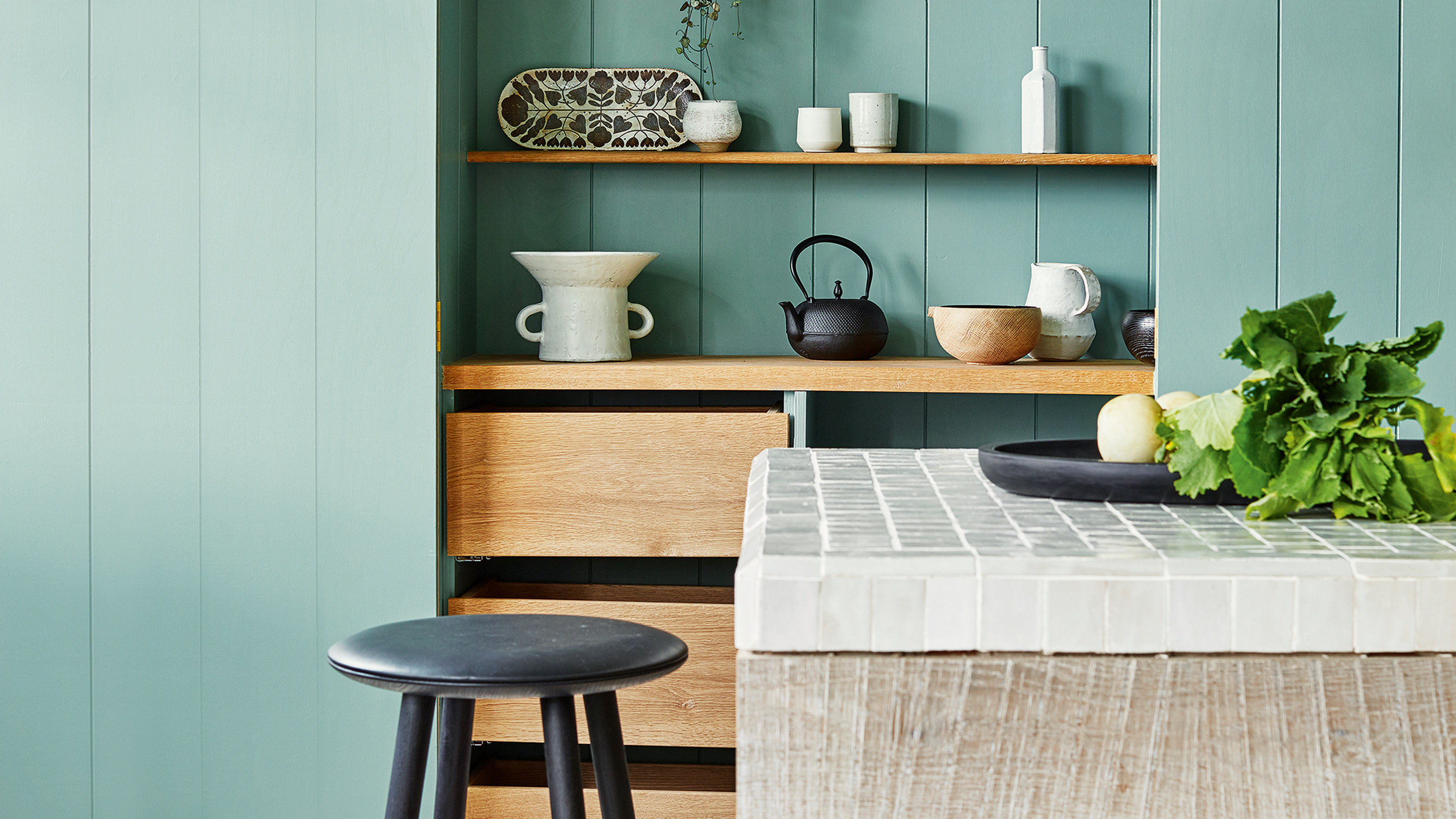
If you’re seeking ways to push the design boundaries on your kitchen’s central feature, look no further than the humble tile. The unexpected application of tiled kitchen island ideas, whether on the front, top and/or sides, can lead to the most incredibly eye-catching centrepiece to your home.
Unless you go for gold-plated designer tiles, tiled kitchen island ideas can also prove a cost-effective way to inject a tonne of colour and character to your kitchen island ideas. Provided they are designed for use on walls, most tiles are suitable for use on island unit – tile onto a tile backer board to achieve a firm, secure fix.
‘Embrace tiles on your island to make it a bold feature and don’t be afraid to be brave,’ encourages Ruth Webber, creative director at Bert & May. ‘Going for outsized patterns and interesting colours will deliver an imaginative island design that’s low maintenance and resilient.’
Tiled kitchen island ideas
Kitchen tile ideas for walls and floors are old news; tiling the kitchen island is where it’s at. Lean into this fresh tiling opportunity with our gallery of inspiring design ideas and unmissable expert advice.
1. Coordinate island tiles and splashbacks

Matching the tiles in your island with other areas of your kitchen and wider home is how the experts establish a cohesive and streamlined look. ‘You could coordinate the tiles in your island with your splashback or a tiled feature wall for a sleek design,’ explains Jen Nash, head of design at Magnet.
‘This is particularly effective in smaller spaces, as it can make the kitchen appear larger. This approach can also work well in open-plan areas where consistency is desired between the kitchen and the surrounding spaces.’
Jen has had more than two decades of experience working with kitchen before joining Magnet in 2020. Here she built a clear design direction that is expressive and considered, with thoughtful details that elevate kitchens in an aspirational yet attainable way.
2. Tile the front of your island

Tiling directly onto the front of your island is a top kitchen island trend for 2024. A stylish and affordable way to add a punch of colour and pattern into your kitchen, tiling behind bar stools will also provide protection from children kicking the cabinets.
Sign up to our newsletter for style inspiration, real homes, project and garden advice and shopping know-how
‘Tiling the front of a kitchen island is incredibly practical. Tiles are simple to wipe clean and robust,’ adds Lee Thornley, founder, Bert & May, who used Hexagonal Split tiles on his own island. ‘We went for tiles that are eye-catching in design and shape but soft in colour, so they draw attention but don’t overwhelm,’ he explains.

After importing reclaimed tiles from Cadiz, Lee joined forces with a family-run artisan tile manufacturer in Andalucía and started selling his own handmade encaustic tiles, officially launching Bert and May in 2013.
3. Get on-trend bamboo tiles
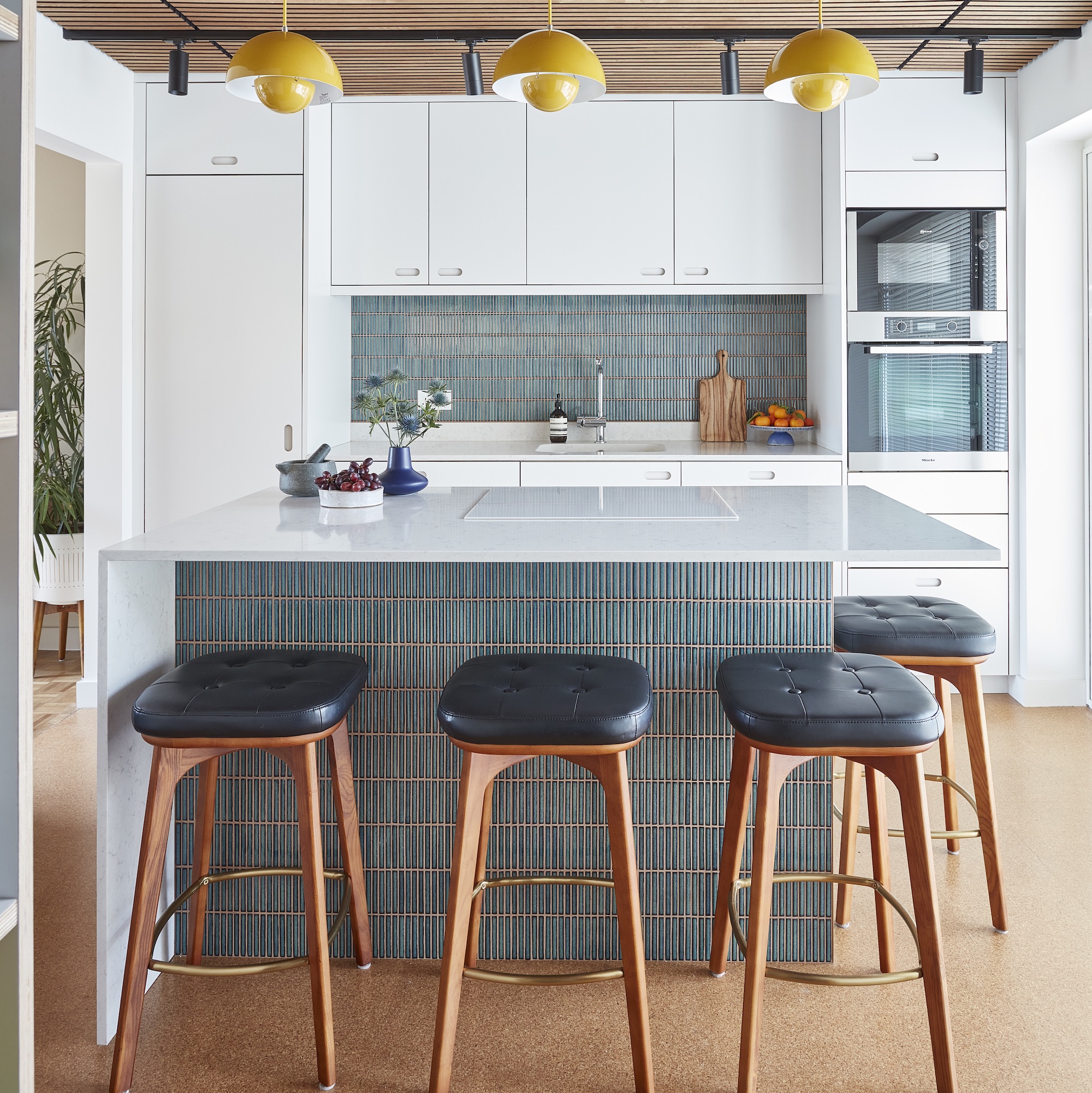
With all things stripey hitting the fashion headlines, Bamboo tiles are emerging as a trendy choice in the kitchen and bathroom this year.
‘Stripes are big business in interiors right now. Bamboo porcelain tiles are made up of matchstick stripes, and with their satin finish that varies from matte to gloss you end up with a surface that provides so much texture and visual interest – perfect for an island unit,’ says Grazzie Wilson, head of creative at Ca' Pietra.
To maximise impact, Grazzie recommends colour-contrasting grout. ‘We’d go for a grout that didn’t take away from the beauty of the tiles, and so would stick with traditional white to make each bamboo strip pop. For extra wow, use the same tiles on your splashback to tie to the two areas together.’

Grazzie has worked in the interiors industry for more than a decade. At Ca’ Pietra, one of the UK’s leading stone and tile brands, she heads up creative, overseeing product collections as well as the company’s distinctive brand, look and feel.
4. Go modular with mosaics

Tiling an island on four of its five sides creates a modular effect that’s fresh and funky. The grid-like symmetry of the mosaic tiles on this island design by GRT Architects lends a cool, retro feel. Only the inner elevation is left untiled for cupboards and appliances.
‘Using the same style and dimension of tiles on the floors and splashbacks but switching to a rich Du Vin Rouge colourway on the island helps it stand out yet feel cohesive in the space,’ says founding partner, Tal Schori, GRT Architects.
5. Tile on top
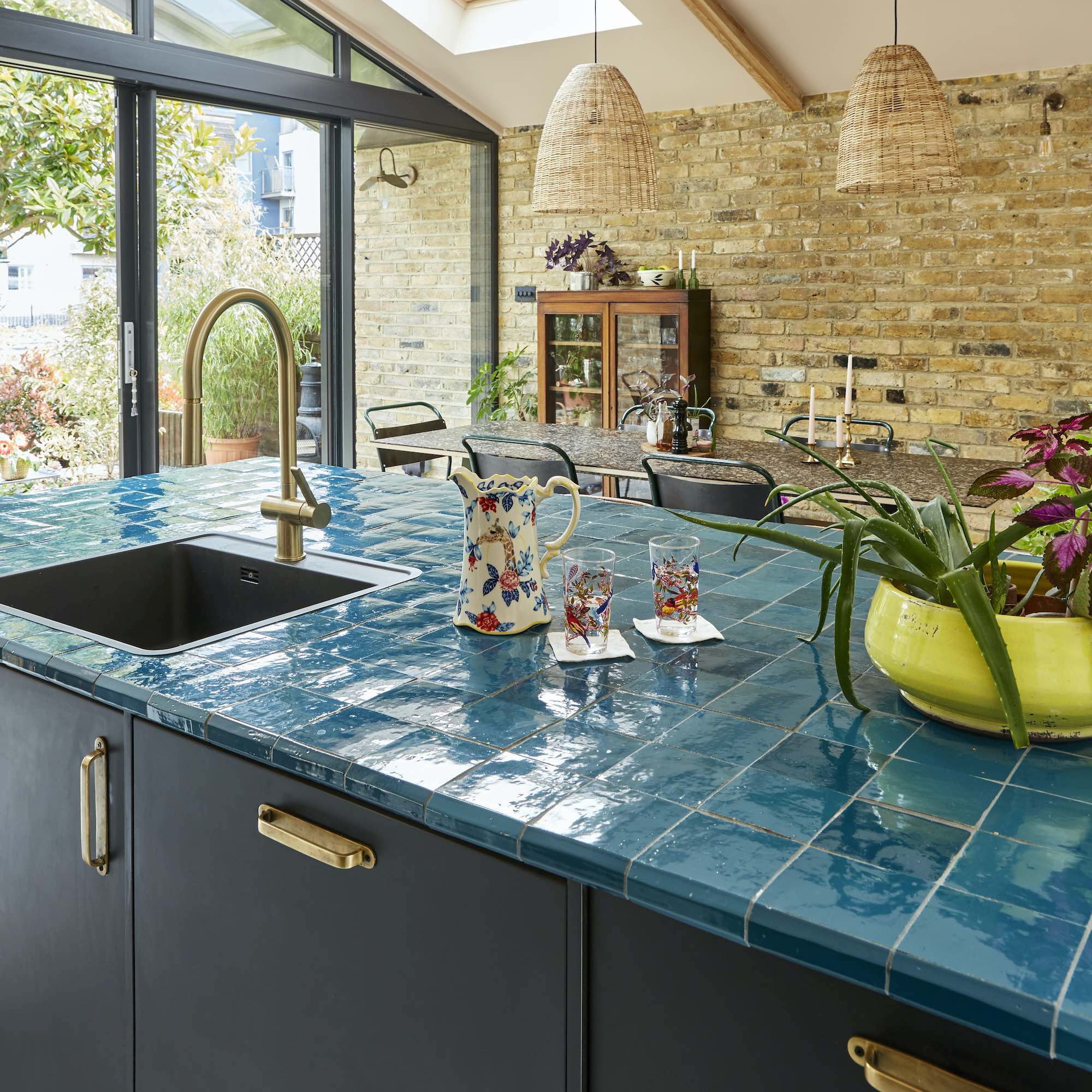
Tiled countertops are making a comeback and if you’re looking to try this style revival, an island unit is the perfect place to start. One of the main advantages of tiled tops is the range of designs, colours and shapes on offer, plus tiles can prove more affordable compared to solid surfaces. You won’t need to pay for templating and fabrication, and if you know how to tile a kitchen splashback, you could DIY.
Do choose robust tiles; porcelain is a good low-maintenance, heat-resistant choice. ‘A tiled island top is not for everyone, primarily because of the grout lines, which can quickly stain, but we really love the look,’ says Krystyna Martin-Dominguez, of K Space Interiors.
Darker grout will help, and you can also seal grout to help protect it from spills. ‘If you’re going for uneven tiles like these handmade Zellige ones, we recommend tiling a sample board big enough to test the surface with a glass of water and a pot to decide if can live with the undulating surface.’
6. Explore tile shapes and patterns

Like wallpaper for your kitchen island, but infinitely more practical, tiles can inject a splash of colour and pattern into your culinary space. With a kaleidoscope of hues, shapes, and designs at your fingertips, you can be as bold or subtle as your heart desires.
‘This fun island combines both stripes and hexagons for a bold design statement,’ says Grazzie from Ca’ Pietra. ‘Since the hexagon shape of this tile allows for several interesting patterns – think of it as a pattern within a pattern – you can create vertical, horizontal or Zig-Zag stripes, as well as herringbone or starburst layouts. Which one you go for is down to personal choice.’
7. Add luxe with metallic tiles
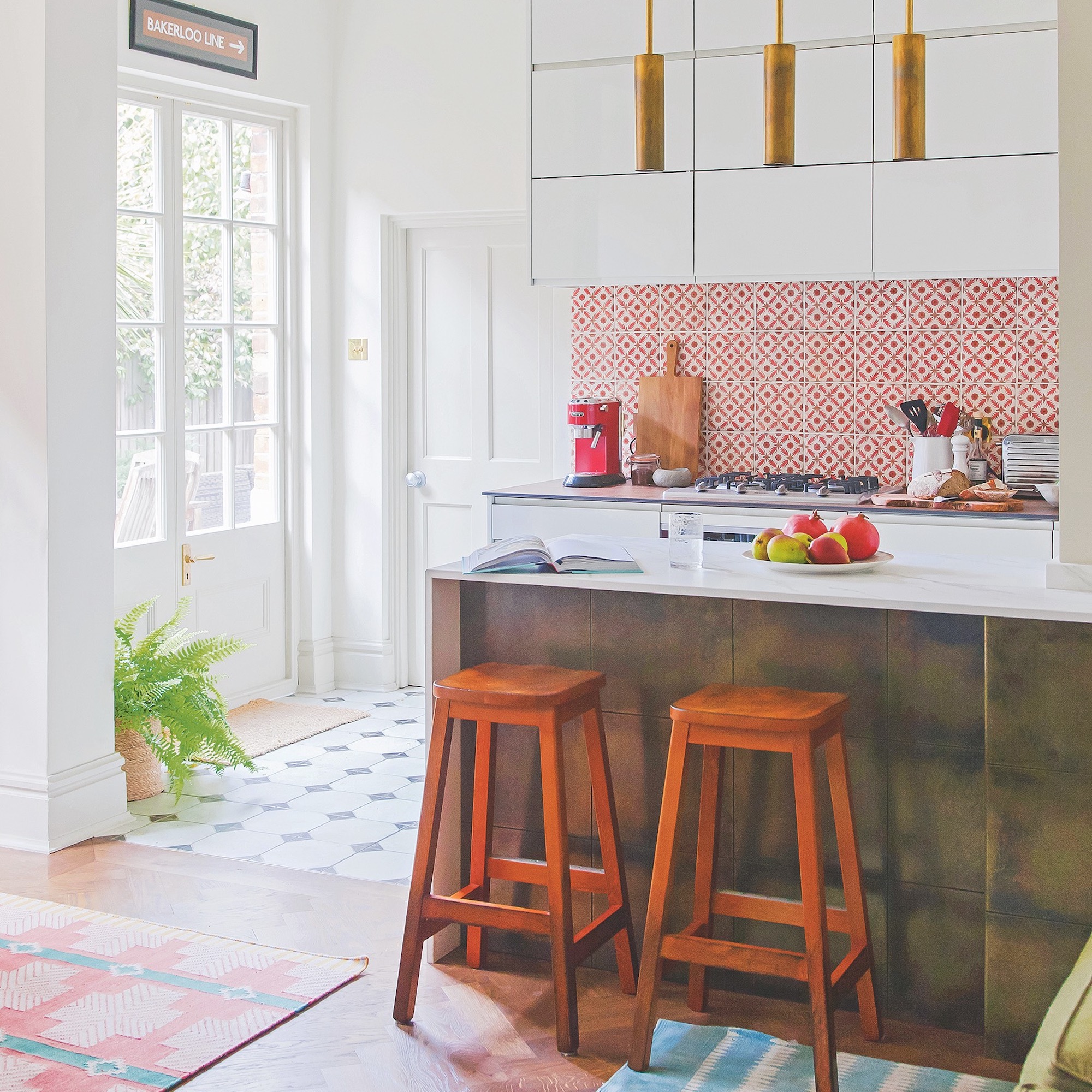
Cladding kitchen islands in luxe metals like brass, bronze and copper is a popular move and can provide beautiful results. But have you consider getting the look using metallic tiles instead? Ca’ Pietra’s Grazzie Wilson explores the benefits.
‘The on-going trend for luxe metals means there are some eye-catching tile designs available and, being made from porcelain, can prove a better alternative to sheet metal as they don’t patinate and dull over time and are easier to clean,’ explains Grazzie.
‘If you do decide to add metallic tiles to the front of your island, our recommendation is to play to the material’s strength by adding down-lighting under the kitchen worktop to make the most of the glamour it affords.’
8. Choose textural tiles
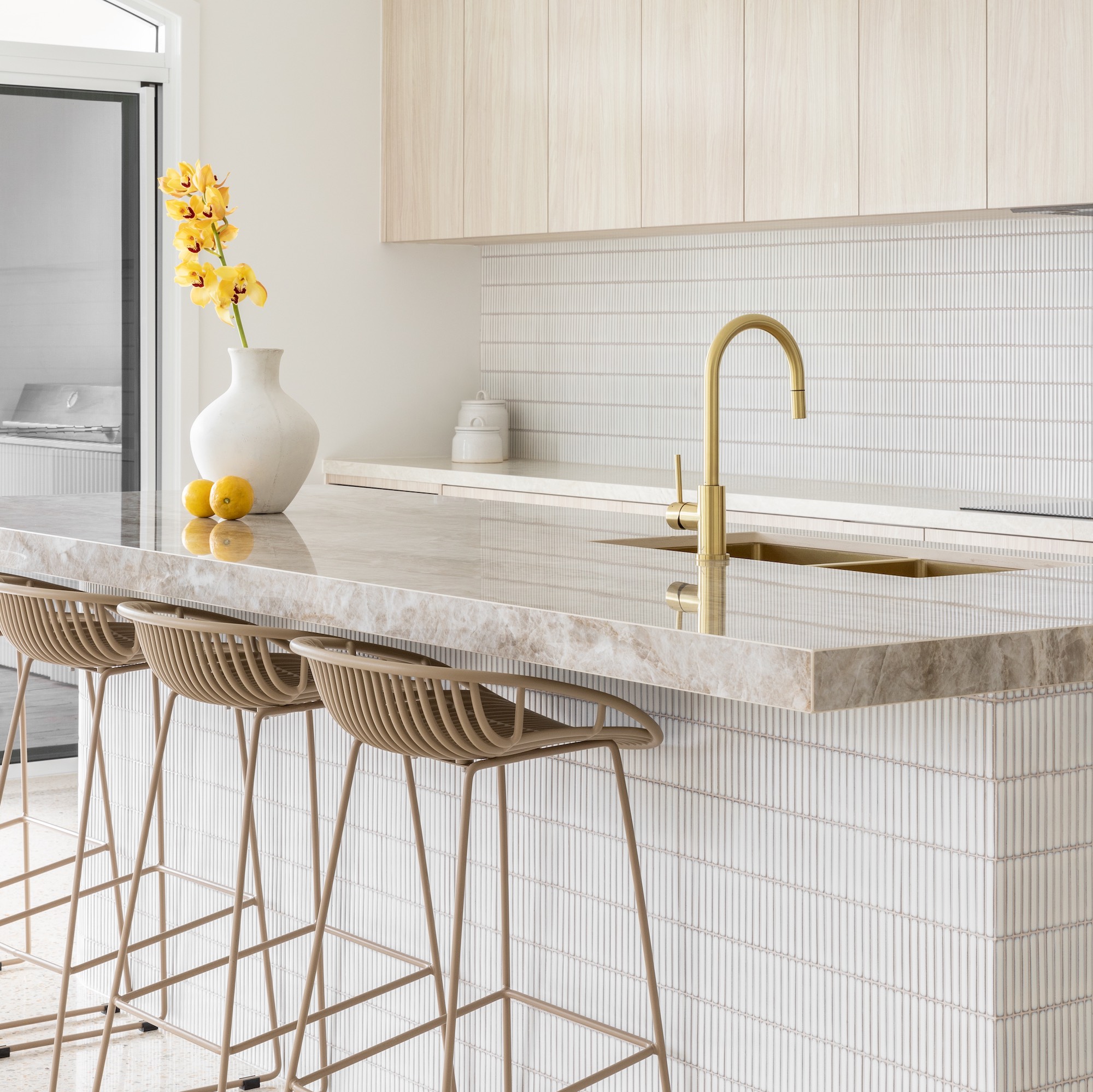
Incorporating textured tiles on a kitchen island is a savvy way to prevent a neutral scheme from appearing flat and lifeless. The contrast between smooth worktops on the horizontal surface, and textured tiles on the vertical elevations will up the energy and interest on your kitchen’s central feature.
‘Whether it’s through natural tiles like travertine and clay or porcelain tiles in ribbed, raised or fluted patterns, adding texture will not only enhance the overall warmth and depth of the kitchen island design but will also create a more inviting and visually intriguing space,’ says interior designer Renee Enoka, from ABI Interiors
Renee Enoka is an in-house interior designer and Product Marketing Executive at ABI Interiors. Renee brings a wealth of knowledge in project management for renovations, spearheading architectural product marketing initiatives, and designing showroom installations and construction projects.
9. Embrace retro pattern, terrazzo style
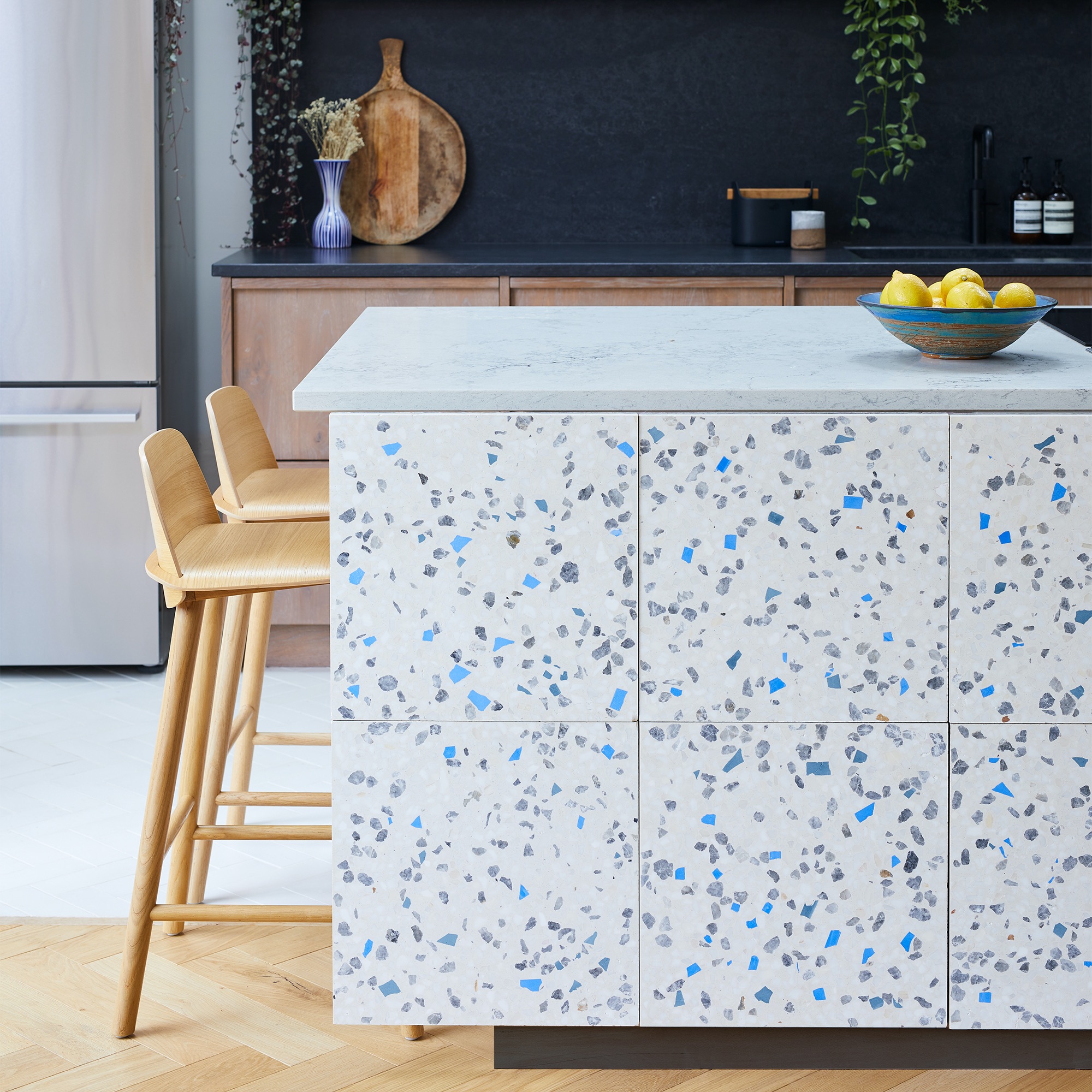
Terrazzo tiles offer a playful way to infuse pattern and colour into a kitchen island, adding a touch of modern retro charm to the heart of the home. Usually featuring multiple colours, terrazzo is great for coordinating kitchen design, as you can pick out different chip shades and use on accessories and other surfaces.
Authentic terrazzo tiles are made from a mixture of chips of marble, quartz, and/or granite, which poured into a cement or epoxy resin base. Once cured, the surface is polished to create a smooth and durable finish.
You can also get some incredible terrazzo lookalikes in porcelain, which are generally lighter and more affordable but can lack sparkle and interest compared to the real deal. ‘Terrazzo can be soft with a delicate randomised pattern. On an island, terrazzo is a subtle way to add pattern and often works well in a pastel palette,’ adds Ruth Webber, creative director at Bert & May.
10. Add uniqueness with reclaimed tiles
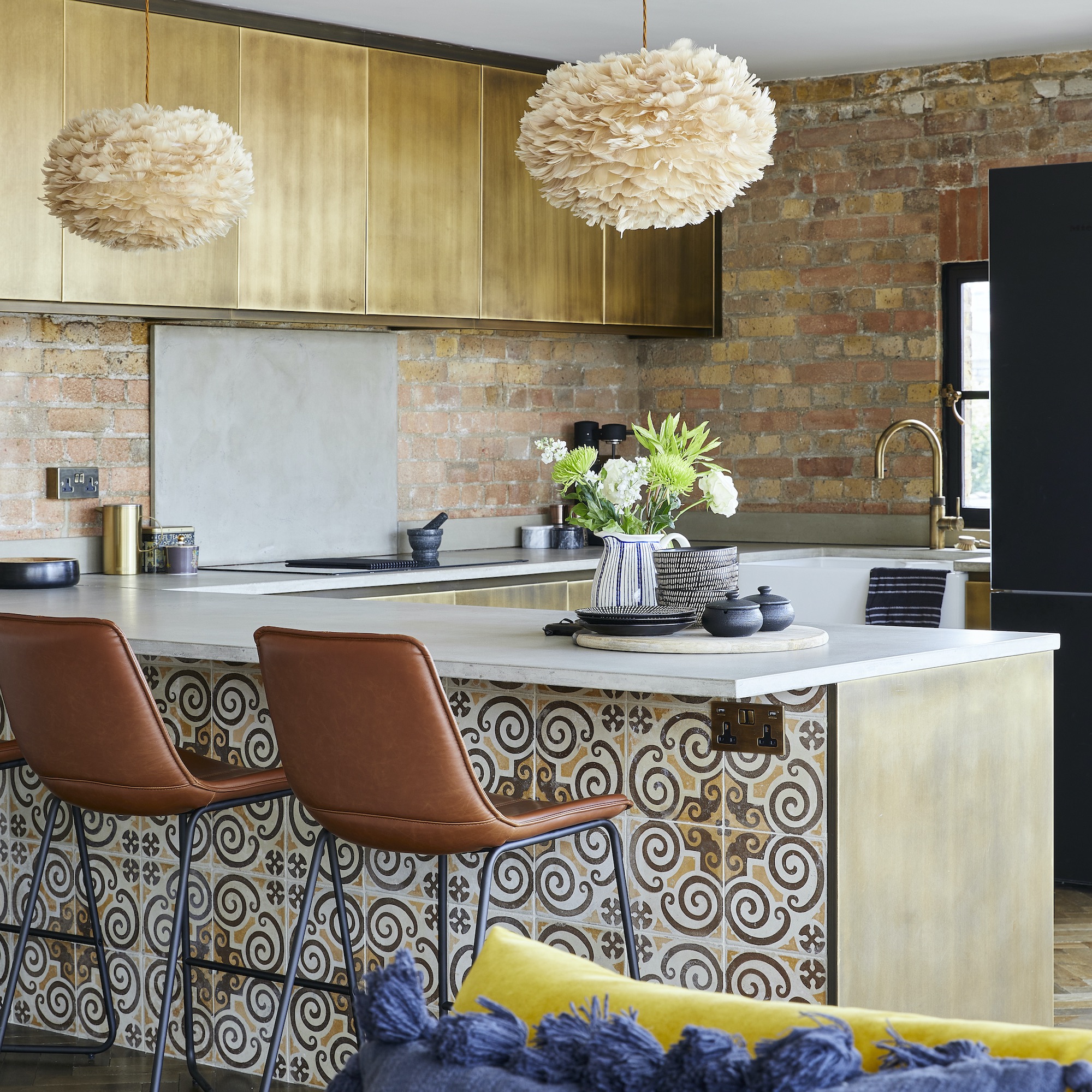
Why settle for ordinary when you can make a unique design statement on your kitchen island using salvaged tiles with an authentic sense of history and charm?
‘The fact they have a vintage feel worked well – especially if you want to do something in keeping with the property, something that doesn't look brand new or too manufactured or pristine,’ interior designer Cathy Emmins.
When buying reclaimed tiles, look carefully for any signs of major damage and wear. Variations in colour and texture add extra charm and character but they shouldn’t be excessively chipped or cracked. Antique cement tiles may benefit from a coat of sealant before and after installation to protect from stains or moisture damage.
FAQs
Should I tile my kitchen island?
Tiled kitchen island ideas may be a big interiors trend but it’s not for everyone. Yes, you can choose tiles that are heat resistant, durable and waterproof, which makes them a hardwearing choice, but grout lines can be problematic on the staining front, so make sure you know how to clean grout properly.
And, depending on the tile design you go for, a tiled island can be a Marmite feature with the potential to put off future buyers. Tread carefully if you’re hoping to move up the property ladder.
Ultimately, the decision to tile your kitchen island comes down to your personal preferences and how well it fits with the overall design and functionality of your kitchen. If you love the look of tiled islands, then we always recommend going for it with gusto – a timid execution will only disappoint. Make a firm commitment and tile with pride.
Should the entire kitchen be tiled?
Tiling the entire kitchen – floors, walls and the kitchen island – has several advantages. We’re talking about ease of cleaning, durability, and design versatility. With tiled surfaces all around, cleaning up spills and splashes is a breeze, making it ideal for busy family life. Then there’s the virtually limitless design options at your fingertips.
However, on balance, tiling the entire kitchen is not wise. The cost of tiling, compared to painting, can quickly escalate, especially if you need to add in professional labour costs. And you should if you are anything besides brilliant on the tiling front. Few DIY botches are more unforgiving than bad tiling.
Then there’s tile overwhelm, which can really unbalance a perfectly lovely kitchen, not to mention the sterile, echoey effect of too many hard surfaces in one room. If you’re planning to tile your island, we’d recommend restraint on the tiling front elsewhere.
Tiled kitchen island ideas offer endless possibilities for creativity and expression, as well as the chance to personalise the heart of your home to reflect your taste and style. Why settle for ordinary when you can turn your kitchen island into a stunning focal point with stylish and versatile tiles?

Linda Clayton is a professionally trained journalist, and has specialised in product design, interiors and fitness for more than two decades. Linda has written for a wide range of publications, from the Daily Telegraph and Guardian to Homes & Gardens and Livingetc. She has been freelancing for Ideal Home Magazine since 2008, covering design trends, home makeovers, product reviews and much more.